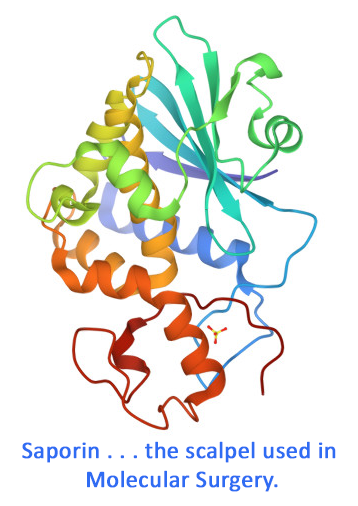The dopamine transporter (DAT) is a sodium-dependent reuptake carrier that is suspected to play a role in such neurologic and psychiatric disorders as Parkinson’s disease, Tourette’s syndrome, schizophrenia, and addiction. It is a 12-transmembrane domain transporter with the N- and C-terminus regions located within the cytoplasm. Because of its importance in dopamine use, DAT is an identifier of dopaminergic neurons. Specific elimination of cells that express DAT is useful in studying the role of dopaminergic neurons in one of the devastating diseases of old age, Parkinson’s.
Anti-DAT-SAP is a chemical conjugate of a rat monoclonal antibody to the second extracellular loop of the dopamine transporter (DAT-ECD) and the ribosome-inactivating protein, saporin. It is highly specific for cells that express DAT, including mesencephalic dopamine neurons of the substantia nigra, pars compacta, and ventral tegmental area.
Anti-DAT-SAP is available individually (Cat. #IT-25) or as a kit (Cat. #KIT-25) which includes Anti-DAT-SAP and Rat IgG-SAP (Cat. #IT-17).
keywords: dopamine transporter, dat, dat-nt, n-terminus, Anti-DAT-NT, Anti-Dopamine Transporter, Dopaminergic neurons, Parkinson’s disease, addiction, brain, neuroscience
Dissociable attentional effects of dopaminergic and cholinergic lesions to the anterior cingulate cortex
Clement MK, Pimentel CS, Swaine JA, Pimentel AJ, Hutchins D, McGaughy JA (2019) Dissociable attentional effects of dopaminergic and cholinergic lesions to the anterior cingulate cortex. Neuroscience 2019 Abstracts 418.11. Society for Neuroscience, Chicago, IL.
Summary: Prior work from our lab has shown that excitotoxic lesions to the anterior cingulate cortex (ACC) impairs the ability of rats to filter certain types of distracting stimuli (Newman and McGaughy 2011). Specifically, rats with lesions of the ACC cannot filter distractors that have been made salient through pairing with reinforcement. In contrast, these same subjects can filter distracting stimuli that have not been predictive of reward. The present study investigates the effects of neuromodulator specific lesions of the same region to determine how specific neuromodulators contribute to the attentional function of ACC. Cholinergic or dopaminergic deafferentation of the ACC was achieved using either 192 IgG saporin (n=10) or dopamine transporter saporin (n=10). Lesions were restricted to the rostral portion of the area and did not spread to nearby prefrontal sub-regions e.g prelimbic cortex. After lesioning, subjects were tested in an attentional set-shifting task (Birrell and Brown 2000). While both cholinergic and dopaminergic lesions increased distractibility, these deficits were not as severe as those produced after excitotoxic lesions (n= 8). In contrast to excitotoxic lesions, both cholinergic and dopaminergic lesions also impeded formation of an attentional set. Because dopaminergic lesions produced impairments in many stages of the tasks, we hypothesized that these subjects had a more general impairment in stimulus processing. In order to address these broader processing impairments, we analyzed the data to determine whether lesioned rats showed more sensitivity to novel stimuli, or made more perseverative errors. The implications of these data for understanding the unique contributions of acetylcholine and dopamine to attentional processing in the ACC will be discussed.
Related Products: 192-IgG-SAP (Cat. #IT-01), Anti-DAT-SAP (Cat. #IT-25)
Macrophage migration inhibitory factor mediates peripheral nerve injury-induced hypersensitivity by curbing dopaminergic descending inhibition.
Wang X, Ma S, Wu H, Shen X, Xu S, Guo X, Bolick ML, Wu S, Wang F (2018) Macrophage migration inhibitory factor mediates peripheral nerve injury-induced hypersensitivity by curbing dopaminergic descending inhibition. Exp Mol Med 50(2):e445. doi: 10.1038/emm.2017.271
Objective: To investigate whether the proinflammatory cytokine MIF participates in the regulation of neuropathic hypersensitivity by interacting with and suppressing the descending dopaminergic system.
Summary: MIF functions as a braking factor in curbing dopaminergic descending inhibition in peripheral nerve injury-induced hypersensitivity by mediating Th gene methylation through G9a/SUV39H1-associated H3K9 methylation.
Usage: Anti-DAT-SAP was injected i.t. or i.c.v. with ISO-1 alone or ISO-1 combined with one of the other regulators on Day 7 post-nerve injury for 14 days, and pain behaviors, including 50% withdrawal threshold, mechanical pressure and thermal withdrawal latency, were observed throughout the 70 days post nerve injury.
Related Products: Anti-DAT-SAP (Cat. #IT-25)
Targeting of the receptor protein tyrosine phosphatase beta with a monoclonal antibody delays tumor growth in a glioblastoma model.
Foehr ED, Lorente G, Kuo J, Ram R, Nikolich K, Urfer R (2006) Targeting of the receptor protein tyrosine phosphatase beta with a monoclonal antibody delays tumor growth in a glioblastoma model. Cancer Res 66(4):2271-2278. doi: 10.1158/0008-5472.CAN-05-1221
Summary: The receptor protein tyrosine phosphatase ß (RPTPß) is overexpressed in astrocytomas, and is a potential target for tumor therapy. After testing antibodies against an extracellular domain of RPTPß in vitro with Mab-ZAP (Cat. #IT-04), two custom conjugates, 7E4B11-SAP and 7A9B5-SAP, were created by Advanced Targeting Systems. The authors tested the custom conjugates, using anti-DAT-SAP (Cat. #IT-25) as a positive control, and mouse IgG-SAP (Cat. #IT-18) as a negative control. The 7E4B11-SAP conjugate displayed significant antitumor activity in mice engrafted with U87 glioma cells.
Related Products: Mab-ZAP (Cat. #IT-04), Anti-DAT-SAP (Cat. #IT-25), Mouse IgG-SAP (Cat. #IT-18), Custom Conjugates
Suppression of natural killer cell activity by morphine is mediated by the nucleus accumbens shell.
Saurer TB, Carrigan KA, Ijames SG, Lysle DT (2006) Suppression of natural killer cell activity by morphine is mediated by the nucleus accumbens shell. J Neuroimmunol 173(1-2):3-11. doi: 10.1016/j.jneuroim.2005.11.009
Summary: In this work the authors investigated the role of dopaminergic projections to the nucleus accumbens in modulation of immune parameters such as morphine-induced suppression of splenic natural killer (NK) cell activity. Studies have indicated that acute exposure to opioids decrease NK cell-mediated cytotoxicity. Rats received bilateral 0.5 µg-injections of anti-DAT-SAP (Cat. #IT-25) into the nucleus accumbens shell. Treated animals showed no immunosuppression upon administration of morphine, indicating that dopaminergic neurons in the nucleus accumbens play a major role in this pathway.
Related Products: Anti-DAT-SAP (Cat. #IT-25)
browse all references for this product | back to top


Reviews
There are no reviews yet.